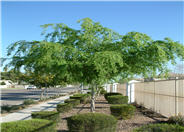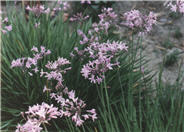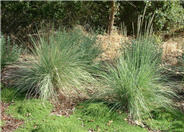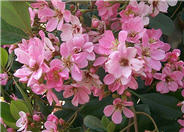
Common name:Chinese Elm, Chinese Evergreen Elm
Botanical name:Ulmus parvifolia
Chinese Elm quickly reaches 50' tall and 60' wide with an upright habit and spreading pendulous branches with age. Chinese Elm has small, dark green leaves. Foliage turns yellow or orange in fall. Small, greenish yellow flower appear in summer but are considered insignificant. Small light brown fruit appear in fall but are not noticeable. Bark is brown gray but with maturity, exfoliates to reveal orange patterns.

Common name:Society Garlic
Botanical name:Tulbaghia violacea
This clumping perennial will grow less than 1' tall and has narrow, blue-green leaves. Clusters of lavender flowers bloom in spring and summer. Leaves and flowers have a distinct onion or garlic smell if crushed.

Common name:Lindheimer's Muhly
Botanical name:Muhlenbergia lindheimeri
Native to Mexico and TX, this stunning clump-forming grass is a winter dormant grass in cold climates, but usually semi-deciduous in mild climates. From the fall into winter emerge the 5' tall upright flower inflorescence, that rise well above the blue- grey foliage. The flowers are at first purple, then mature to a grey color. Best in full sun with regular watering but will tolerate drought and light shade. -Randy Baldwin
San Marcos Growers

Common name:Rhaphiolepis Pink Lady
Botanical name:Rhaphiolepis indica 'Pink Lady'
This slow-growing plant will only grow 4'-5' high and has dark green, thick foliage. It produces clusters of pink flowers that bloom in spring and clusters of black fruit in the fall. 'Pink Lady' is a vigorous grower to 4'-5' tall and 4'-6' wide, a size which can easily be kept smaller with occasional pruning.
| Designer: | Path Through Mulch |
Photographer: GardenSoft |
Soils and Compost:
Maintain a two to four inch layer of mulch on the soil surface to reduce weeds, infiltrate rain water, and reduce compaction.
Water Saving Tip:
Change spray sprinklers to low-flow bubbler or drip systems. Shrubs and trees are ideal candidates for this type of irrigation because the water is applied directly to the root zones.
Integrated Pest Management:
Drip and other smart irrigation delivers water directly to roots, allowing no excess water for weeds.
